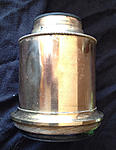Hello,
please help with the ID of following lens -



At first it looks like a Petzval, but the front element is not cemented and is much smaller than the rear, which is air separated and a quality build.
So, the question is - what is it ? A cheap (or early, or both) Petzval where the front group just was not glued ? Or some transition from a verres combines to Petzval ? Or something else
A manufacturer id would be also nice.
br,
rado




 Reply With Quote
Reply With Quote
Bookmarks